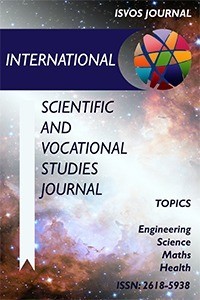Association between Prior Pain Intensity, Back Function and The Characteristics of Episodes in Patients with Low Back Pain
functional status, recurrence, risk factors., Association
Association between Prior Pain Intensity, Back Function and The Characteristics of Episodes in Patients with Low Back Pain
Association, Functional status, Recurrence, Risk factors,
___
- [1] F. Balagué, A. F. Mannion, F. Pellisé and C. Cedraschi, “Non-specific low back pain,” Lancet, vol. 379, no. 9814, Feb., pp. 482-491, 2012.
- [2] A. H. Almoallim, S. Alwafi, K. Albazli, M. Alotaibi, and T. Bazuhair, “A simple approach of low back pain.” International Journal of Clinical Medicine, vol.5, no:17, Semp., pp. 1087-1098, 2014.
- [3] N. Gouveia, A. Rodrigues, M. Eusébio, S. Ramiro, P. Machado, H. Canhão, and J. C. Branco, “Prevalence and social burden of active chronic low back pain in the adult Portuguese population: results from a national survey,” Rheumatol Int., vol. 36, no. 2, Feb., pp. 183–97, 2016.
- [4] J. B. S. Garcia, J. J. Hernandez-Castro, R. G. N. M. Ar Pazos, J. O. Aguirre, A. J. W. Delgado, M. Serpentegui, M. Berenguel, and Catalin Cantemir, “Prevalence of low back pain in Latin America: a systematic literature review,” Pain Physician, vol. 17, no. 5, Semp-Oct., pp. 379–91, 2014.
- [5] M. Kahere, and T. Ginindza, “The prevalence and risk factors of chronic low back pain among adults in KwaZulu-Natal, South Africa: an observational cross-sectional hospital-based study,” BMC Musculoskelet Disord. vol. 15, no. 22, Nov., pp. 955-965, 2021.
- [6] T. da Silva, K. Mills, B.T. Brown, R.D. Herbert, C.G. Maher, and M.J. Hancock, “Risk of recurrence of LBP: a systematic review,” J Orthop Sports Phys Ther. Vol. 47, no.5, May, pp. 305–313, 2017.
- [7] T. R. Stanton, J. Latimer, C. G. Maher, and M. Hancock, “Definitions of recurrence of an episode of LBP: a systematic review,” Spine (Phila Pa 1976). No.34, no.9, Apr., pp.316-322,2009.
- [8] D. Goubert, R. De Pauw, M. Meeus, T. Willems, B. Cagnie, S. Schouppe, J. Van Oasterwijck, E. Dhondt, and L. Danneels, “Lumbar muscle structure and function in chronic versus recurrent LBP: a cross-sectional study,” Spine J. Vol.17, no.9, Sep., pp.1285–1296, 2017.
- [9] M. Koc, B. Bayar, and K. Bayar, “A Comparison of Back Pain Functional Scale with Roland Morris Disability Questionnaire, Oswestry Disability Index, and Short Form 36-Health Survey,” Spine. Vol. 43, no.12, June, pp. 877-882, 2018.
- [10] M. Melloh, A. Elfering, T.R. Stanton, T. Barz, E. Aghayev, C. Röder, and J. C. Theis, “LBP risk factors associated withpersistence, recurrence and delayed presentation,” J Back Musculoskelet Rehabil. vol.27, no.3, Aug., pp.281-289, 2014.
- [11] F. Faul, E. Erdfelder, A. Buchner, and A. G. Lang, “Statistical power analyses using G*Power 3.1: Tests for correlation and regression analyses,” Behav Res Methods. vol.41, no.4, Nov., pp.1149-1160, 2009.
- [12] T. S. Carey, J. M. Garrett, A. Jackman, and N. Hadler, “North Carolina Back Pain Project. Recurrence and care seeking after acute back pain: results of a long-term follow-up study,” Med Care. vol.37 no.2 Feb., pp.157-164, 1999.
- [13] J. M. Stevans, A. Delitto, S. S. Khoja, C. G. Patterson, C. N. Smith, M. J. Schneider, J. K. Freburger, C. M. Greco, J. A. Freel, G. A. Sowa, A. D. Wasan, G. P. Brennan, S. J. Hunter, K. I. Minick, S. T. Wegener, P. L. Ephraim, M. Friedman, J. M. Beneciuk, S. Z. George, and R. B. Saper, “Affiliations expandet al. Risk Factors Associated With Transition From Acute to Chronic LBP in US Patients Seeking Primary Care,” JAMA Netw Open. vol.4, no.2, Feb., pp.e2037371- e2037398, 2021.
- [14] L. A. Elders, and A.Burdorf, “Prevalence, incidence, and recurrence of LBP in scaffolders during a 3-year follow-up study,” Spine. vol.29, no.6, Mar., pp.101–106, 2004.
- [15] T. R. Stanton, N. Henschke, C. G. Maher, K. M. Refshauge, J. Latimer, and J. H. McAuley, “After an episode of acute LBP, recurrence is unpredictable and not as common as previously thought,” Spine (Phila Pa 1976). vol.33, no.26, Dec., pp.2923-2928, 2008.
- [16] M. J. Hancock, C. M. Maher, P. Petocz, C. C. Lin, D. Steffens, A.Luque-Suarez, and J. S. Magnussen, “Affiliations al. Risk factors for a recurrence of LBP,” Spine J. vol.15, no.11 Nov., pp.2360–2368, 2015.
- [17] E. M. Ardakani, C. Leboeuf-Yde, A. Jacques, and B. F. Walker, “The prognostic merit of self-reported triggers of recurrent LBP: study protocol,” Chiropractic & Manual Therapies. vol.28 no.1, Jan., pp.1-7, 2020.
- ISSN: 2618-5938
- Yayın Aralığı: Yılda 2 Sayı
- Başlangıç: 2017
- Yayıncı: Umut SARAY
Applicability Of Incineration Technology In Waste Management: Istanbul Case Study
Mehmet TAŞTAN, Mehmet Nurettin UĞURAL
Coping Methods Used by Students of a Health School for Dysmenorrhea Management
Özgür ALPARSLAN, Dilek ÖCALAN, Funda DEMİRTÜRK
Runge Kutta Optimization for Fixed Size Multimodal Test Functions
Fatih CANTAŞ, Serdar ÖZYÖN, Celal YAŞAR
Ahmet TOLUNAY, Mustafa MALKOÇ, Mehmet ÖZMIŞ
Experimental Analysis of Pneumatic Motion Control Application with Piezo Technology
Çiğdem GÜNDOĞAN TÜRKER, Fikret AKYÜZ
Investigation of Global Warming Case of Antalya
Ayşe Nur OYMAK SOYSAL, Şule ŞİMŞEK, Atiye KAŞ ÖZDEMİR, Şule FIRINCI
Munise Didem DEMİRBAŞ, Didem ÇAKIR (SOFUOĞLU)
Investigation Of The Conversion Procedures For Fossil Fuel Vehicles To Electric Vehicles In Turkey
